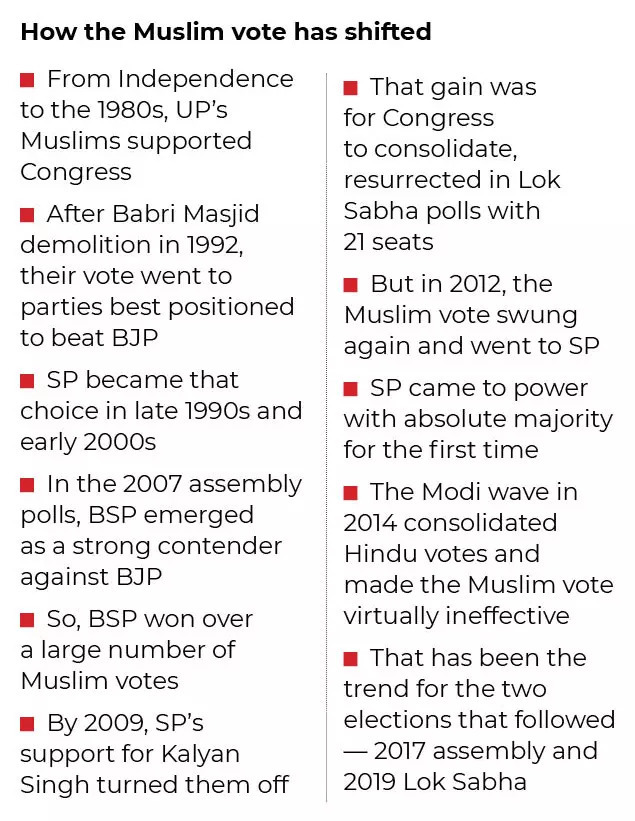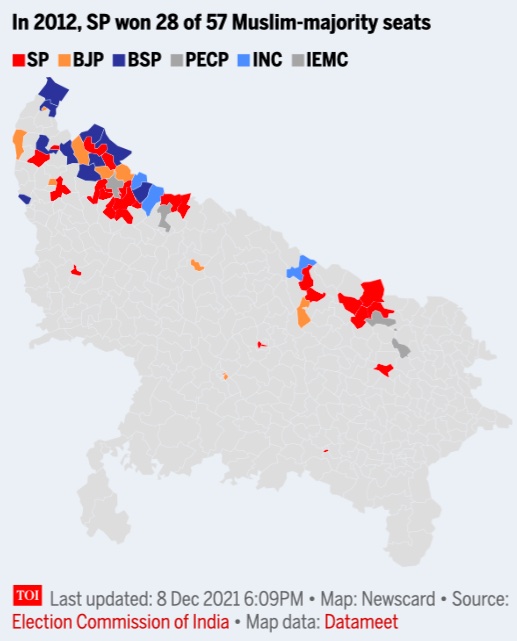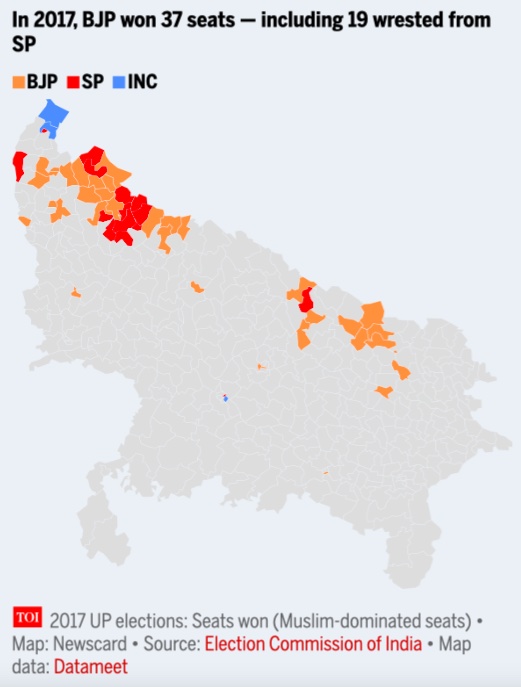Muslims in Indian politics
This is a collection of articles archived for the excellence of their content. |
Contents |
Representation in state assemblies
Uttar Pradesh
1951- 2012

The Times of India
See graphic:
Community MLAs in Assembly, 2012 and muslim MLAs in UP Assembly, 1951-12
1994-2017
Parvez Iqbal Siddiqui, February 14, 2022: The Times of India

From: Parvez Iqbal Siddiqui, February 14, 2022: The Times of India

From: Parvez Iqbal Siddiqui, February 14, 2022: The Times of India

From: Parvez Iqbal Siddiqui, February 14, 2022: The Times of India

From: Parvez Iqbal Siddiqui, February 14, 2022: The Times of India

From: Parvez Iqbal Siddiqui, February 14, 2022: The Times of India

From: Parvez Iqbal Siddiqui, February 14, 2022: The Times of India

From: Parvez Iqbal Siddiqui, February 14, 2022: The Times of India

From: Parvez Iqbal Siddiqui, February 14, 2022: The Times of India
The support of the Muslim community, which accounts for more than 19% of UP’s population, was always considered crucial for any party to form a government. Until 2014.
That year, BJP reached out to OBC (other backward classes) and MBC (most backward classes) voters as a part of its targeted Hindu consolidation for the Lok Sabha polls. The minority vote was left marginalised electorally. Not one Muslim MP made it to the Lok Sabha.
And by the next assembly election in 2017, the number of Muslim MLAs also dwindled to 25. It was a sharp drop from the 68 in 2012 — the highest ever in the UP assembly and, possibly, a polarising political talking point. This, when there are over 120 assembly constituencies out of the total of 403 which have a sizeable Muslim population – 20% or more. In Rampur, Muslims constitute more than 50% of the population. In Moradabad and Sambhal, it is 47%. Bijnor, Saharanpur, Muzaffarnagar, Shamli and Amroha, too, have over 40% Muslims. Five other districts have a Muslim population between 30% and 40%, and 12 districts have 20% to 30% Muslims.
What happened to the Muslim vote?
Despite its numerical strength, the community has seen that its strategy of backing the most powerful candidate to defeat the BJP nominee in each constituency has not worked in the three recent elections — 2014 Lok Sabha, 2017 assembly and 2019 Lok Sabha.
This time, political parties, perhaps as a way to stop counter-polarisation of Hindu voters, have been noticeably silent on Muslim issues. Whether it is fielding Muslim candidates or backing anti-Citizenship Amendment Act protests, non-BJP parties have been mostly silent. Samajwadi Party (SP), historically a strong supporter of Muslim welfare, is no longer showcasing how many Muslim candidates it has fielded so far.
Bahujan Samaj Party (BSP) has moved its social engineering focus from the Dalit-Muslim combination to the Dalit-Brahmin alignment. None of the major opposition players has even come up with any community-specific promise in their manifestos. Political observers said that given the existing political circumstances silence might be “better than speech.”
Many Muslim voters think so, too. Instead of giving any handle to the BJP to polarise the election.
Voting pattern
2021: state assembly elections
May 5, 2021: The Times of India
Assembly Elections 2021: How Muslims voted in the state elections
When it comes to politics, especially electoral politics, the march of civilisation seems to pause if not stop. Votes are shought, and cast, not only on how many schools, roads or hospitals have been built in a constituency but also on how pro or anti a party and its candidate is seen towards a religion — or the followers of a faith.
The clearest evidence of this ‘should-have-no-place-in-modern-society’ feature of Indian elections is the discussion on polarisation of voters. Usually termed as polarisation between majority and minority (meaning Hindus and Muslims everywhere except in Jammu & Kashmir) votes, tracking this trend has become more significant since 2014 when the appeal for votes along religious identity has become more open.
The trend isn’t new. But instead of diluting over time, it has been intensifying at least in public debate. One rough way to measure the presence and extent of polarisation is to look at how different parties and alliances performed in constituencies where Muslims have a higher share in total population than their average share in the state.
Here’s what an analysis of the four states that went to polls recently shows.
Assam
Going by the results, the state was most polarised among the four where elections were held last month. The BJP-led National Democratic Alliance (NDA), perceived to be less minority-friendly, did not win a single seat in the 34 constituencies with sizable Muslim presence. Its vote share too was less than half (27%) of Congress-led UPA’s (62%)
Fortunes were reversed in the 92 constituencies where Muslim presence is insignificant. There, NDA grabbed 75 seats and 52% share of votes. Among states without a Muslim majority, Assam has the highest share of Muslims.
Of the total 126 seats in the Assam Assembly, NDA won 75 with 44.5% of votes polled, whereas UPA took 50 seats with 43.5% vote share. Other parties got 1 seat with 12% votes
Constituencies with significant share of Muslim voters are mostly in Barak Valley and in Lower Assam.
West Bengal
Compared to Assam, BJP seems to have done a shade better in parts of Bengal that have significant Muslim voters. The party won 21 of 141 such seats with a vote share of 35%. The Left-Congress-India Secular Front alliance that most overtly appealed for Muslim votes got one seat--it’s only win in the state. What is unclear from this quick and not-too-detailed analysis is the extent to which Hindu votes consolidated with BJP in these constituencies. In UP and Bihar, the party had won several seats in areas with significant Muslim population, most likely because Hindu votes went almost entirely to it. The phenomenon has been termed ‘reverse polarisation’ in some political analyses.
BJP’s vote share in places without significant Muslim voters was 6 percentage points higher (compare the two charts) allowing it to win a little over a third of the seats in such constituencies
Of the 292 seats in the Bengal Assembly, the Trinamool Congress (AITC) won 214 with 48.3% of votes going in its favour. BJP+ took 77 seats with 38% vote share. Left+Cong+ISF got 1 seat with 10% votes.
Constituencies with significant share of Muslim voters are not concentrated in any one or two areas of the state.
Tamil Nadu
This southern state has one of the lowest populations of Muslims in the country. Therefore, the constituencies studied here for possible polarisation included a relatively higher population of two minorities--Muslims and Christians.
Surface- level observation shows that the DMK-led alliance, which was considered more secular, scored significantly better in places with relatively higher minority voters by securing twice as many seats as the AIADMK alliance that had BJP as a partner.
In places where minority voters were insignificant, the AIADMK alliance narrowed the vote share gap significantly, though it won less than half the seats.
Of the total 234 seats in the TN Assembly, DMK+ won 159 grabbing 45.4% of votes polled. AIADMK+ took 75 seats with 39.7% vote share. All others got 15% votes, but no seats in the Assembly.
Constituencies with higher share of Muslim and Christian voters are scattered across the state.
Kerala
This state had the distinct feature of BJP not being part of two principal and traditionally strong alliances — the LDF and the UDF. So the dramatically different seat share of these two alliances in constituencies with significant Muslim population had little or nothing to do with Hindu-Muslim vote split.
What is perhaps mildly suggestive of polarisation is the difference in vote share of the NDA between areas with higher and lower number of Muslim voters. The BJP-led alliance did get a higher share of votes where minorities are not significant.
Of the total 140 seats in the Kerala Assembly, LDF won 99 with 45.3% share of votes. UDF won 41 seats with 39.4% of votes. Others got 15% votes, but didn't win a single seat.
North Kerala has significantly higher presence of Muslim voters than the southern region of the state.